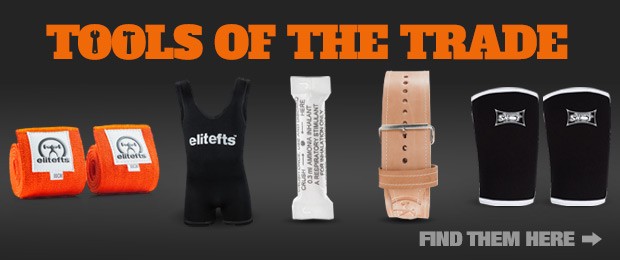
2019 was a big one. It was my first full year in Florida. I got back on the platform for the first time in 18 months. I hit meet PRs on every lift, both raw and equipped. 2019 also had me bombing out for the first time, battling with shoulder issues, and experiencing meet day circumstances that I was not prepared for.
With all of that, here is what 2019 taught me with lessons to take to your next meet:
1. Don’t be afraid to take a step back.
While training for the RPS Central Florida Throw Down, I didn’t have enough variation in my max effort bench movements. I was hitting the same plane of motion with the same grip and a similar ROM week in and week out. I got beat up and my bench regressed quickly after.
Through that meet prep, I was so set on hitting my first 500-pound raw bench that in my head, I couldn’t back off. I was afraid of backing off. I thought backing off would cost me my shot at 500. Soon, the low 400s were feeling sketchy. When all hope was lost, I finally listened to those around me. I deloaded at three weeks out, took an opener at two weeks out, then deloaded into the meet. I didn’t hit 500 at the meet, but I came out with small PR and healthy shoulder.
After the meet, I took three weeks off of a barbell. For the next four weeks, my main movements were close grip inclines and floor presses. On the fifth week back to regular training, I smoked my first 500-pound raw bench. Had I been smarter, deloaded sooner, and put more variation into my bench training, I would have had a much better shot at making the 500 count in a meet.
The lesson: If you are run down, beat up, and regressing into a meet, think hard on whether or not pushing through is the best option. Sometimes, you need to fight through the pain and get the job done. Other times, taking a step back, deloading, and giving yourself a chance to come into the meet fresh will produce a much better result.
2. Accessory work isn’t always about how much weight you are moving, but it is about what you are getting out of it.
Early in the fall, my wife and I drove to North Carolina to train with Brian Hill and his crew. For those of you who are unaware, Brian is a guy who is known for being much stronger than his accessory work would indicate. Of course, me being young, dumb, and fresh off of doing sloppy 700-pound good mornings a few weeks earlier wanted to talk shit. That plan worked great until Brian showed me how he does GMs: He was far more precise. He was loading exactly what he wanted to load. I was just bending over and praying I didn’t die. My way got some likes on Instagram, but Brian’s hit my hamstrings and glutes way harder, and better yet, didn’t leave me walking funny the next day.
The lesson: Accessory work doesn’t always need to be loaded up, but it does need to be done in a manner that produces the desired results. It isn’t necessarily about the weight, but it is about how much you are taxing the muscles involved. Being more precise and doing movements with intention will give you more for less. Once you’ve figured out how to get the most from a movement, who’s to say you can’t start slapping some plates on?
3. If you miss your opener, don’t go up. ESPECIALLY IN MULTI-PLY EQUIPMENT.
This was a hard one. In October after squatting a 99-pound multi-ply PR, my bench warm-ups were feeling a little bit off. I figured once I was on the platform, I would be able to put it together. I figured wrong. I missed my opener. I still had my eyes set on a total and to get that total, I told myself I needed to go up. In the moment, I was convinced that I missed because of how I had my shirt set. I added weight to the bar, jacked the shirt, and guess what? Another miss. The third didn’t go any better with how little gas I had left in the tank. With how I felt on warm-ups, I should have had the brains to drop my opener. With how my opener went, I should have known to retake it. My ego got in the way. I lost sight of the big picture.
The lesson: In order to get a big total, you first need to get a total. Pick your openers appropriately. If you feel off on warm-ups, adjust them accordingly. If you miss your opener for any reason, you’d better not go up.
4. On meet day, whatever situation you find yourself in, let it be and move on.
On two occasions in 2019, I found myself having to deal with less than ideal circumstances on meet day. Both situations put me through more mental strain than they should have.
In May, as I locked out my second attempt deadlift, I watched the head judge begin dropping his hand. I started lowering the bar. The head judge's hand stopped moving. He hadn’t said down yet. No down command meant three reds. The first thought through my head was that I blew it. The second was “What if I miss again?”
In December, I was ready to redeem myself for my October bomb out. I had every intention of repeating my previous squat performance and then some. Flash forward to my squat opener: As soon as I unracked it, something felt very wrong. It felt way too heavy for what was supposed to be on the bar. I took it and I got crushed. Why did it feel so heavy? What was wrong with me? I had no idea what I could do to make it go better—I thought I was on my way to another bomb out.
About five minutes later, we were informed that the bar was miss loaded 50 kilograms too heavy for my opening attempt. Although that was a relief, the mental tailspin already had begun.
In both of the above situations, I was fortunate enough to have a great group of people around me to pull me out of my head. In May, I was able to pull my third deadlift and get the total I wanted. In December, I was able to get a big enough squat in to hit a PR total.
If I had better control of my thoughts and been able to move on instead of growing more frustrated as time went, both of those situations could have been made much less stressful. If I had better control of my thoughts, the overall outcome at each meet could have been better
The lesson: No matter how well you prepare for a meet, things can go sideways. If they do, accept it, move on, and make the best of it. Dwelling and putting yourself in a mental pit is only going to make the day worse.
5. A good training crew is invaluable.
As I mentioned in point number four, it wasn’t me who got myself back on track at those meets — it was my crew. If it wasn’t for them, I would have likely missed out on a few of my 2019 goals.
Furthermore, since moving to Florida I have progressed much faster than I thought possible. Why? It isn’t any of my own doing. What is different is that I am surrounded by far more experienced lifters. I am surrounded by people who have been there and done that. I am surrounded by people with very similar goals to my own. I am surrounded by people who hold their friend’s success in the same regard as they hold their own.
Here, I am being called out on things that I would miss on my own. I am being told to slow down when I am getting ahead of myself. I am being told to step up when I need to step up. I get to learn from my training partners every single training session. All the while, I get to help them the same way that they are helping me.
The lesson: If there are lifters in your area who are where you want to be and doing what you want to do, you need to train with them. Experience is one of the most valuable assets in powerlifting and if it is accessible, you need to take advantage of it.
If there isn’t anyone around you to train with, consider doing what I did and move.
Seth Albersworth is a powerlifter with experience in and out of gear. His best totals are 2,000 pounds raw and 2,403 pounds multi-ply. Seth has completed his bachelor's degree in kinesiology from the University of Calgary and is currently studying to become a Doctor of Chiropractic at Palmer College of Chiropractic's Florida Campus.











1 Comment